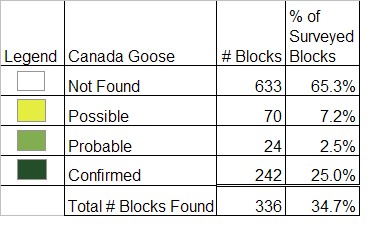Breeding Bird Atlases (BBA)
Find a Bird - BBA1
Breeding Bird Atlas 1 Species Accounts
Canada Goose
Branta canadensis
Egg Dates
April 1 to May 30
Number of Broods
one; may re-lay if first attempt fails.

Few sounds represent the call of the wild better than the drawn-out honking of Canada Geese as they migrate high overhead to and from their arctic breeding grounds and southern wintering sites. That call loses its evocative charm when you hear it daily as geese move between golf course and reservoir.
The Canada Geese that breed in Massachusetts are relatively new to the state. There is little evidence that geese bred here before the 1900s. Two factors led to the establishment of the present population. Prior to the arrival of European colonists, the forested Northeast provided little in the way of suitable goose nesting habitat, except for some of the offshore islands. As people cleared the forests, built mill and farm ponds, and later made large reservoirs, goose habitat was also created.
Second came the importation of geese. Bird fanciers kept a few Canada Geese in their collections, but wealthy hunters imported birds from Michigan, North Carolina, and other areas for use as live decoys. When this practice was outlawed in 1935, large numbers of geese were liberated, and they joined others that had previously been released or had escaped. These birds were a mixture of races and forms, but a Midwestern subspecies described as the "Giant" Canada Goose predominated. They were large, hardy types able to survive severe winter weather and not prone to migrate. Goose populations started to increase very slowly, but, as the best genetically adapted individuals survived and began to breed, numbers reached nuisance levels in some areas by the 1960s. The Division of Fisheries and Wildlife began a program of transplanting goslings from problem flocks in eastern Massachusetts to goose-free areas of the central and western part of the state. By the time the program ended in 1976, geese were breeding throughout the Commonwealth. Numbers were swelled by an influx of geese from Connecticut and New York, where similar events had occurred. Local Canada Goose populations have continued to increase. The 1993 late summer population estimate was 32,000 resident geese based on collar re-sighting data.
Our Canada Geese are largely suburban birds. Many nest in "wild" areas of the state but move into suburban and rural sections in late summer. While some geese may form pair bonds as yearlings, nesting does not occur until they are two years old. Unlike ducks, geese pair for life, and the gander stays with the female all year. However, if one partner dies, the other will re-mate. Breeding in Massachusetts begins in early April, usually about April 10, but sometimes earlier in interior areas and later along the coast. Nests are established on slightly elevated sites such as Muskrat houses, tussocks, and islets. They begin as scrapes, and the females reach out and pull in surrounding cattails and grasses to add to the base and rim. Down is added as egg laying progresses. Normally, only one pair utilizes a small pond, but, when Canada Geese nest on reservoirs, they frequently use larger islands, and many pairs may establish nests in close proximity. Clutches usually contain five or six white eggs, and incubation lasts 26 to 28 days. Most goslings in Massachusetts hatch in a four-week period from May 3 to May 30, especially after May 10.
The goslings leave the nest shortly after hatching, accompanied by both parents. Particularly aggressive females may adopt other youngsters or entire broods, in which case a single pair may be seen with more than twenty downy young. On reservoirs, pairs and broods tend to reform in flocks when the juveniles are four to six weeks old. The parent birds undergo a complete molt during the brood-rearing period and become flightless. They regain flight about the time the young have reached full plumage in late July.
The geese spend the rest of the season grazing on fields of corn or Rye or in shallow water, awaiting winter when some of them will move to areas where they will survive because of food provided by well-meaning residents of cities and suburbs. The Canada Geese in the eastern part of the state show little tendency to migrate, moving instead from frozen reservoirs to major rivers such as the Sudbury, Concord, and Blackstone, or to coastal waters. Birds in the western part of the state are more likely to join flocks of geese migrating south from Canada and may end up as far south as North Carolina, but they more commonly drop out in Long Island Sound or Chesapeake Bay. Some of the western Massachusetts geese move east for the winter.
Map Legend and Data Summary
Atlas 1 data collected from 1975-1979


Note: locally common where suitable wetlands and forage areas occur; spreading and increasing
H.W. Heusmann



